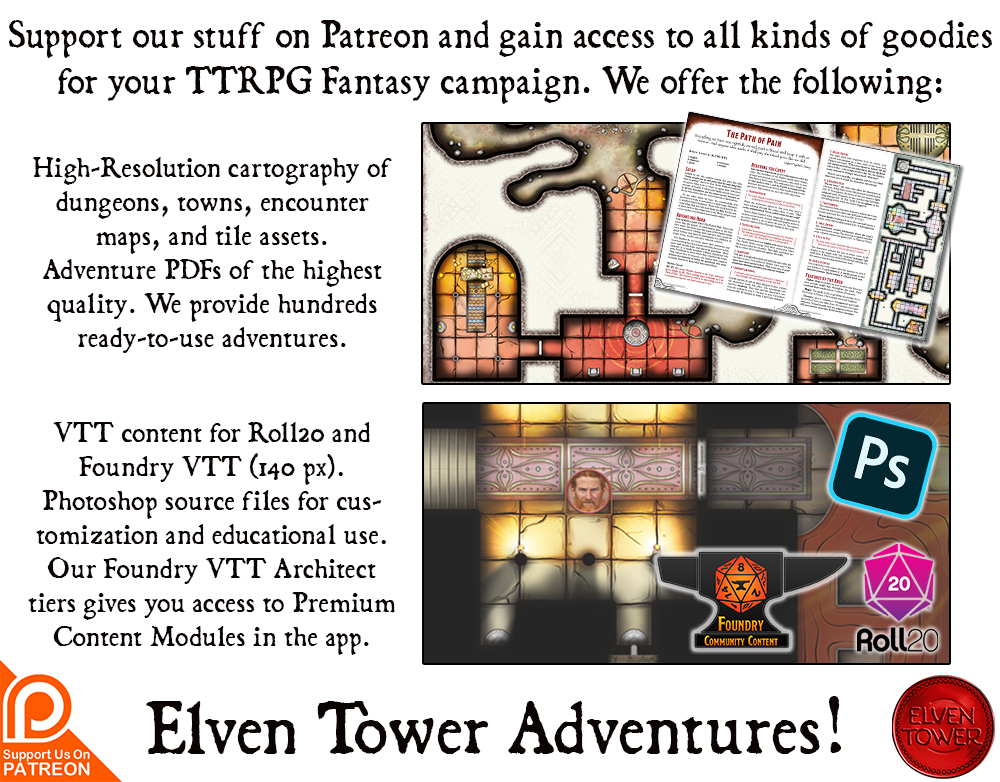This adventuring supplement is designed for D&D5e. On out Patreon page you can get it in PDF format (see image). The downloads include hi-res images for the maps. And there is a variant PDF version designed for Shadowdark RPG.
Beneath the ancient mountains lies Ghin Faradum, where the echo of a hundred hammers and the crackling of fiery forges mingle in the eternal twilight.
Faradak’s Inscription
In the shadowed depths of the world, beneath a mountain range ancient as time itself, lies the dwarven kingdom of Ghin Faradum. This subterranean realm is a network of gargantuan caverns, some illuminated dimly by the soft, bioluminescent glow of mushroom trees and fungal fauna.
The Past
Centuries ago, these deep, cavernous territories were the domain of goblins. The realm was called Kithulat; their society used to be complex and vibrant. However, the arrival of dwarves marked the beginning of a tumultuous era. The Hundred-Year War ensued a brutal conflict that saw the gradual decline of goblin power and influence. As the centuries passed, the goblins’ proud heritage and memories of sovereignty faded, washed away under the relentless advance of dwarven dominion.
After the war, the goblins of now Ghin Faradum became a subjugated people. Relegated to indentured servitude, they toil in the most perilous depths of the mines, their roles as helpers and servants ingrained so deeply that they no longer remember their ancestral legacy. Resigned to their fate, the goblins have come to accept this oppressive life as the normal, natural order, their once-fierce wills dulled by generations of subservience.
A Goblin Hero
After five hundred years, the winds of change begin to stir within the caverns. Rakkar, a goblin born from the very heart of oppression, has emerged as a beacon of revolution. Unlike his brethren, Rakkar’s spirit remains untamed; his heart burns with fiery, unquenchable resolve.
A Time for Change
Secretly rallying his kin in the southern reaches of Ghin Faradum, Rakkar has slowly ignited a spark of rebellion; a glimmer of hope that grows stronger with each whispered tale of freedom. As Rakkar’s tendrils of influence expand, so too does the tension in the dwarven kingdom.
Whispers of discontent and rebellion spread like wildfire among the goblin ranks, challenging the very foundations of dwarven rule. If this ember of rebellion were to erupt into open conflict, Ghin Faradum might once again witness a war as fierce and devastating as the conflicts of old. But this time, after centuries of living off the goblins’ efforts, the outcome of a military conflict is not as clear as it was during the Hundred-Year War.
Level 1-4 Region
- Roads. Narrow, winding paths, half-carved through the ground and stone, seldom trodden except by the occasional lone wanderer or a silent, northbound caravan. Ferries and merchant barges can shorten some trips or travel in a specific direction (see below).
- Ghin River. The copious stream flows into Topaz Lake. People in Faradak sail southward to Topaz Beach instead of getting there by foot. The return trip must be done by roads; the current is too strong to sail on.
- Blue Capped Trees. These towering fungi, with their luminous canopies and sturdy trunks, not only light the darkened halls but also serve the dwarves as a critical resource, providing both wood and other essential materials derived from their unique biology. Most of the farming communities in Ghin Faradum grow mushrooms.
| RUMORS d6 | Details |
| 1 | Some people whisper of a hidden chamber in the deepest part of Ghin Faradum, near the mines located next to King Davek’s Mausoleum. They claim that the walls glitter with veins of pure gold, untouched due to a curse that turns the greedy to stone. |
| 2 | Some miners claim they heard strange sounds at work. They say they are the spirits of goblin bards mourning their lost empire. |
| 3 | A persistent rumor tells of a secret passage connecting Ghin Faradum to the deeper Shadowdark, but no one knows where it is. |
| 4 | There are hushed stories about a mushroom that can heal any ailment, supposedly guarded by a half-spider, half-bat monster. |
| 5 | Among the goblins, there circulates a tale of a hidden library filled with scrolls detailing their people’s grand history. |
| 6 | It is rumored that the goblins are rallying up. No one knows who their leader is or what is the purpose that brought them together. But people fear that a larger conflict may unfold. Goblins in towns and cities are acting strangely, some even going rogue. |
Ghin Faradum Encounters
Roll 1d8 for a Road Encounter when the characters travel to a new location. Roll twice if the characters do not check their surroundings (DC 9 Survival check).
- A party of eight goblin rebels attacks the heroes if a dwarf is among them. They are neutral otherwise.
- A basilisk looks for food. The heroes look tasty.
- A flock of six darkmantles attacks the heroes.
- The characters stumble upon eight myconids. They journey to the Great Bluecap Forest.
- A kobold sorcerer travels with five kobolds. They remain neutral if they are undisturbed.
- The heroes make a wrong turn and end up facing four giant centipedes. They attack fearlessly.
- A goblin shaman protected by six goblins travels toward the Goblinoid Campsite to join Rakkar.
- A goblin boss riding a worg travels with ten goblins. They attempt to imprison the heroes.
Faradak
This is the formidable capital of the dwarven kingdom. Surrounding the city, extensive fields of bioluminescent mushrooms cast a surreal glow, vital for both food and materials, while the broad Ghin River meanders along the city’s eastern flank, essential for irrigation and intricate plumbing. The city is ruled by King Thwayne, whose leadership is as steadfast as the stone walls of his domain. In Stoneheart’s Armory, master smiths craft exquisite weapons and artifacts. The Palace of Topaz houses the Hall of Echoes, a monumental chamber used for council and ceremonies. It is adorned with statues of legendary figures from dwarven history and legends.
Dwarven Rulers
This monument is marked by four towering statues of the legendary military leaders Haggi Ironfist, Durgar Thunderaxe, Nali Stoneblade, and Rawi Hammerfall, each credited with strategic victories in the Hundred-Year War. These statues, masterfully carved from bedrock, depict them holding a bladed weapon in a steadfast pose.
Topaz Beach
Topaz Beach, the serene town nestled beside the shimmering waters of Topaz Lake, stands as the second-largest settlement in Ghin Faradum. Governed by Lady Mirabel Silverstream, a noble known for her diplomatic skills and progressive governance. Unlike the strained relations in other parts of the kingdom, Lady Silverstream has fostered a more inclusive atmosphere where goblins participate in local commerce and community activities as semi-equals, albeit still under dwarven oversight. The bustling marketplaces and vibrant lakeside festivities of Topaz Beach often see a mingling of dwarves and goblins, a testament to the town’s unique approach to inter-ancestries relations. This relative harmony has made Topaz Beach a model of potential coexistence, though not without its underlying tensions and problems.
The Forlorn Ziggurat
Deep within the shadowy reaches of the Great Bluecap Forest lies a strange Ziggurat, an ancient, abandoned military structure shrouded in mystery and moss. This colossal, tiered pyramid, once a nexus of goblinoid worship and magic, now stands silent. Its stone walls and empty halls echo with the whispers of its forgotten glory.
Temple of Lost Faiths
This enigmatic structure predates even the old goblin societies. This temple houses a myriad of idols and effigies, each an abstract representation, adopted and revered by the past goblin society. After the passage of centuries, the original tenets of these beliefs have been watered down in goblinoid society. Only the entity known as the Horned Goddess remains strong. Studying the faiths presented here is of interest for future-planning goblins.
Velvet Garrison
This town is located next to the richest mining veins in Ghin Faradum. Recently, one of Rakkar’s goblin chiefs, emboldened by rising dissent, led his troops in a bold takeover of the town’s central building. This sudden power shift has plunged the town into turmoil, with tensions running high as the goblins assert control over the dwarvish mines and their surrounding areas.
King Davek’s Mausoleum
This solemn and revered site lies buried deep within the richest ore veins of Ghin Faradum, a testament to the king who presided over the tumultuous Hundred-Year War. Placed deliberately amidst the silver, gold, and ores that forged their civilization, his resting place symbolizes the dwarves’ connection to the land and its treasures.
Church of the Horned Goddess
This building stands as a sacred sanctuary dedicated to the mystical deity of the earth. This is a place of worship and old rites, where goblins seek guidance, strength, and protection from their subterranean deity.
Goblinoid Campsite
South of Ghin Faradum, tucked away within a rugged expanse, lies the goblinoid campsite where Rakkar, the rebel leader, marshals his growing forces. This bustling encampment hosts a formidable array of goblins, worgs, and even a few ogres and hobgoblin outcasts who have thrown their lot in with Rakkar’s cause. Tents and makeshift structures sprawl across the area. Under Rakkar’s determined leadership, this diverse assembly sharpens its weapons and stirs its spirits, preparing for the inevitable conflict that looms on the horizon.




